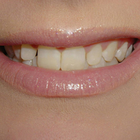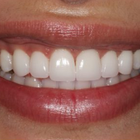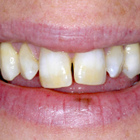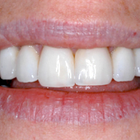Veneers in Madrid
Search and Compare the Best Clinics and Doctors at the Lowest Prices for Veneers in Madrid

Find the best clinics for Veneers in Madrid
With Medijump you can browse 2 facilities offering Veneers procedures in Madrid. The cheapest price available is $106 in Almeria
Veneers in Spain
Price: $ 106
Veneers in Almeria
Price: $ 106
Veneers in Castellon de la Plana
Price: $ 150
Vietnam offers the best prices Worldwide
Price: $ 1
From 39 verified reviews
Elena Torrado Silva, 15 September 2020
Acudí para una extracción de una muela del juicio. Excelente trato por parte del Dr. De la Cruz que me tranquilizo mucho y consiguió que no me enterase a penas de la extracción. Muy profesionales. Muchas gracias !
Clínica González & Campos, located in Calle del Gral Oraa, Madrid, Spain offers patients Veneers procedures among its total of 9 available procedures, across 4 different specialties. Currently, there's no pricing information for Veneers procedures at Clínica González & Campos, as all prices are available on request only, whilst the national average price is approximately €348. There are many specialists available at the Hospital, with 4 in total, and they are accredited by EAFPS - European Academy of Facial Plastic Surgery
Compare Before & After Photos of _procedure_photos.phpVeneers


Front view


Half-side view


Front view


Front view
WHY US?
At Medijump, we're making medical easy. You can search, compare, discuss, and book your medical all in one place. We open the door to the best medical providers worldwide, saving you time and energy along the way, and it's all for FREE, no hidden fees, and no price markups guaranteed. So what are you waiting for?

Free

Best Price

Widest Selection

Risk-Free
What you need to know about Veneers in Madrid

Dental veneers are thin covers that are attached to the surface of teeth to enhance their appearance. The non-invasive dentral procedure is previously popular among those with damaged or discolored teeth. Nowadays, however, the procedure is seen as the ideal method of achieving the ‘perfect smile.'
Veneers can be used to hide uneven, misaligned or simply imperfect teeth. The veneers are cemented over the existing teeth and fixed into place – there are two main types of veneer; Porcelain and Composite. Porcelain veneers are more expensive and appear more natural, being made in a laboratory so require multiple visits. There is often the need to alter the existing teeth, removing some of the mass. Composite veneers are made of the same materials used for cavity fillings. They can usually be made quickly, and are sculpted directly on the teeth instead of in a laboratory. Thus allowing the procedure to be done in a day.
What does a Veneers Procedure Involve?
Veneers are used primarily for aesthetics. This type of treatment procedure is perfect for people who have gaps in their teeth, stains, as well as people who may have chipped a tooth. Veneers are custom-made shells designed to fit the shape of your teeth and to be attached to your front teeth to improve the size, shape, color, and length.
Two main types of veneers are:
- Composite Veneer - this type can be created by your dentist on the same day and directly applied to your teeth. You will only need a single appointment to complete the procedure.
- Porcelain Veneer - this type is manufactured in a laboratory. Opting for a porcelain veneer will require you to have two appointments. First, is to prepare your teeth (enamel removal) and mold a model of your teeth to be created in the lab. The second is to finally cement your veneers onto your teeth.
The most commonly used type of Veneer is the Porcelain Veneer as it appears more natural and can resist stains better than composite veneers. Besides the two main types of veneers, some dentists may also offer no-prep veneers. These may include specific brands of procelain veneers like Vivaneers and Lumineers. They are less invasive to apply since the layers of tooth under the enamel aren't removed.
In terms of anesthetics, local anesthesia is not usually required while undergoing the whole procedure. However, depending on how you handle pain and discomfort, you may request to receive local anesthesia or sedation.
Aside from giving you a pleasing smile, veneers are resistant to staining and offer the best fix to broken or damaged teeth.
How Long Should I Stay in Madrid for a Veneers Procedure?
This type of procedure is an outpatient treatment, meaning you may be able to go home after undergoing the procedure. However, you will be required to do a follow-up check-up with your dentist to assess the placement of your veneers and in most cases, the procedure has to be carried out over 2 separate occasions, just a day or two apart. Since this is a non-invasive treatment, stitches are not required, but you will be required to stay in Madrid for at least a few days.
What's the Recovery Time for Veneers Procedures in Madrid?
There is actually no recovery time after the placement of your veneers. You can also return back to your daily routines including exercise immediately after your trip. As for the enamel removal, you may experience some mild discomfort for about a week. It is best that you avoid very hot or cold foods, including hard, chewy or crunchy food. When your sensitivity wears off, you can return to your normal dietary habits.
What sort of Aftercare is Required for Veneers Procedures in Madrid?
Once your dental veneers have been placed and you have completed the whole procedure, you should commit yourself to good oral hygiene, regular visits to your dentist and a good healthy lifestyle. Dental Veneers can last beyond 10 years now, however, just like your natural teeth, veneers are also still susceptible to damage. This is why aftercare is very important to help with the longevity of your new teeth.
What's the Success Rate of Veneers Procedures in Madrid?
Over the past years, many studies have reported that over 91% of people who have had dental veneers experienced highly positive results. However, potential risks and side effects after undergoing this procedure are a possibility. Just like any other dental restoration, dental veneers can have some side-effects, for example:
- Tooth sensitivity - since this procedure will require the removal of some enamel, your teeth will become slightly sensitive, following the placement of your veneers.
- Response from gum tissues - your gum tissue might take some time to adjust to your newly placed veneers. Expect to have some minor inflammation and/or discomfort in your gums.
- Risk of trauma - once your teeth’s enamel is removed, it will become more sensitive, thus it will be even possible for the pulp within your teeth to die.
- Possible Issues with placement - it's possible for your teeth to have issues with decay or chipping along the outer portion of your veneers. Gum irritation may also be possible. Other problems may include rough-edged veneers and overhanging veneers.
- Overall Discomfort - experiencing some discomfort after the procedure is to be expected. If you are particularly sensitive, it is advisable that you take an over the counter medication to help you relax and treat your pain.
Are there Alternatives to Veneers Procedures in Madrid?
You also have to be aware that this type of treatment option is not for everyone. If you are not a good candidate to undergo the procedure, note that there are still possible alternatives that will be suited for you. These alternatives may include:
Orthodontics - if you have severely crooked teeth or malocclusion, dental veneers are not for you. You may want to consider a more comprehensive orthodontic procedure to treat your case.
Dental crowns - these are quite similar to dental veneers. These are also custom-made to match the shape of your teeth. However, unlike veneers, a crown extends all the way around your tooth, meaning your dentist will remove a large portion of your dental structure. These crowns are perfect for patients who have considerable damage that affects the strength and structure of their teeth.
Bonding - often called composite veneers. This is typically for patients with an insufficient amount of tooth enamel.
Whilst the information presented here has been accurately sourced and verified by a medical professional for its accuracy, it is still advised to consult with your doctor before pursuing a medical treatment at one of the listed medical providers
No Time?
Tell us what you're looking for and we'll reachout to the top clinics all at once
Enquire Now

Popular Procedures in Madrid
Prices Start From $1

Prices Start From $1

Prices Start From $48

Prices Start From $1

Prices Start From $1

Prices Start From $1

Prices Start From $11

Prices Start From $45

Recommended Medical Centers in Madrid for Veneers

- Interpreter services
- Translation service
- Religious facilities
- Medical records transfer
- Medical travel insurance
- Health insurance coordination
- TV in the room
- Safe in the room
- Phone in the room
- Private rooms for patients available

- Interpreter services
- Translation service
- Religious facilities
- Medical records transfer
- Medical travel insurance
- Health insurance coordination
- TV in the room
- Safe in the room
- Phone in the room
- Private rooms for patients available

- Interpreter services
- Translation service
- Religious facilities
- Medical records transfer
- Medical travel insurance
- Health insurance coordination
- TV in the room
- Safe in the room
- Phone in the room
- Private rooms for patients available
Veneers in and around Madrid
About Madrid
Madrid is the capital and most populous city in Spain and the city continues to charm its visitors with glorious fashion, amazing food, and lively nightlife. Beyond its culture and beauty, Madrid is also a convenient medical tourism destination, particularly for residents of Western Europe. Many of the best JCI-accredited and high-quality hospitals in Spain are located within this city and these hospitals are well-regarded for high standards, both in terms of staff and facilities. The doctors and medical professionals are highly trained and will make sure to give you the best of care. Furthermore, the city has one of the most affordable healthcare systems on the continent. Popular treatments include orthopedic surgery, dental treatments, and general checkups. Infertility treatments are particularly popular and are attracting medical tourists from all over Europe.
Popular Parts of Madrid
From amazing masterpieces, upbeat nightlife, amazing local cuisine, to beautiful architecture, there’s plenty to see in Madrid. The most popular area is Plaza Mayor, which is the city’s main square where visitors can stroll around its winding streets to find many churches and tapas bars. This area will give insights into the city’s royal history and architecture. The most popular sites around the plaza are Ayuntamiento and San Pedro. Those who want to learn more about Madrid’s culture should visit the Prado Museum. It is one of the most amazing art galleries in the world displaying the works by the great European masters, such as Raphael, Bosch, Rubens, Goya, and Velázquez. On sunny days, people usually go to El Retiro Park to unwind and relax.
Transport in Madrid
Adolfo Suárez Madrid–Barajas Airport is the main airport in Madrid and is the second-largest airport by physical size in Europe. It serves both domestic and international flights to and from numerous major cities around the world. Getting around in Madrid is fairly easy since the city has an effective public transport system. The best way to get around is by the metro, which has an extensive network and will take visitors almost everywhere around the city. Buses are a great option as well, and metered taxis are widely available.
Visas in Madrid
As a member of the Schengen Area, Spain allows citizens of 62 countries, including the US, Canada, and Australia, to visit and stay without a visa for up to 90 days. Citizens of other countries are required to apply for a visa to be able to enter Madrid and It is highly advisable to check at your nearest Spanish embassy or consulate for the requirements.
Weather in Madrid
Spring (March-May) is one of the wettest times in the city, but it does offer pleasant weather. Autumn (September – October) is also quite pleasant, with the average temperatures hovering around 15°C. Summer (June – August) can be very hot, with the temperatures rising to 37°C on the hottest days. Winter is chilly, with the average temperature dropping to 8°C.
Additional Info
- Local Currency: The Euro is the currency and 1 EUR is equivalent to approx. 1.12 USD.
- Money & Payments: It’s easy to find ATMs in Madrid and credit cards are widely accepted. In some areas, tipping can be expected.
- Local Language: The official language is Spanish and many people speak good English.
- Local Culture and Religion: The largest religion is Christianity. However, other religions, such as Islam and Judaism, are also widely practiced.
- Public Holidays: New Year's Day, Day of Murcia, and Christmas Day are some of the most celebrated holidays in the city.
Popular Searches
- Plastic Surgery in Thailand
- Dental Implants in Thailand
- Hair Transplant in Thailand
- Breast Augmentation Thailand
- Gastric Sleeve in Thailand
- Gender Reassignment Surgery in Thailand
- Laser Hair Removal in Bangkok
- Botox in Bangkok
- Dermatology in Bangkok
- Breast Augmentation in Bangkok
- Coolsculpting in Bangkok
- Veneers in Turkey
- Hair Transplant in Turkey
- Rhinoplasty in Turkey
- Stem Cell Therapy in Mexico
- Rhinoplasty in Mexico
- Liposuction in Mexico
- Coolsculpting in Tijuana
- Rhinoplasty in Korea
- Scar Removal in Korea
- Gastric Sleeve in Turkey
- Bone Marrow Transplant in India
- Invisalign in Malaysia
- Plastic Surgery in the Dominican Republic
- Tummy Tuck in the Dominican Republic
- Plastic and Cosmetic Surgery in Poland
- Rhinoplasty in Poland
- Hair Implant in Poland
- Dental Implants in Poland
- IVF in Turkey

